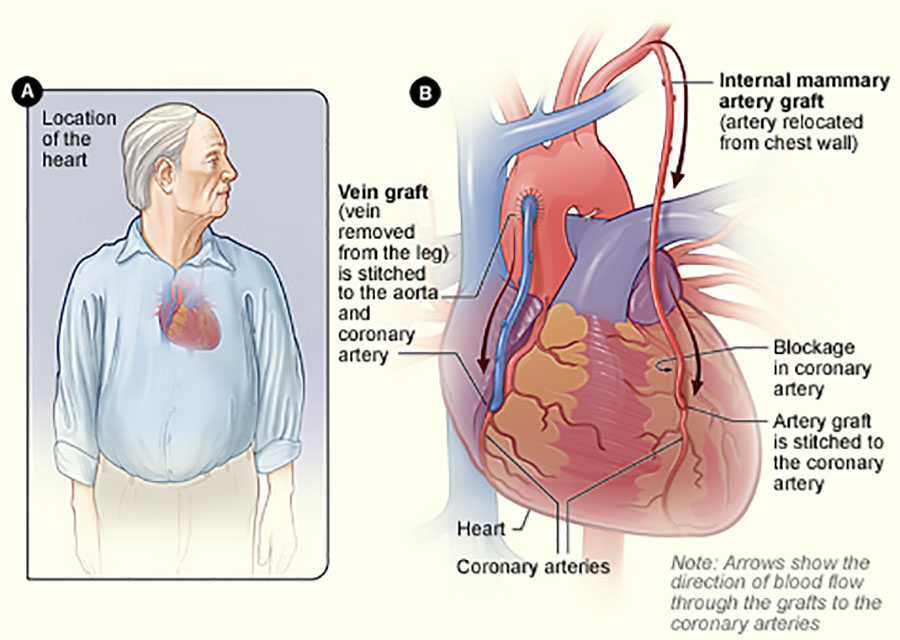Answers About Coronary Artery Bypass Grafting (CABG)
Coronary artery bypass grafting (CABG) is a type of surgery that improves blood flow to the heart. Surgeons use CABG to treat people who have severe coronary heart disease (CHD).
CHD is a disease in which a waxy substance called plaque builds up inside the coronary arteries. These arteries supply oxygen-rich blood to your heart.
Over time, plaque can harden or rupture (break open). Hardened plaque narrows the coronary arteries and reduces the flow of oxygen-rich blood to the heart. This can cause chest pain or discomfort called angina.
Visit the CRH Heart & Vascular Center
If the plaque ruptures, a blood clot can form on its surface. A large blood clot can mostly or completely block blood flow through a coronary artery. This is the most common cause of a heart attack. Over time, ruptured plaque also hardens and narrows the coronary arteries.
CABG is one treatment for CHD. During CABG, a healthy artery or vein from the body is connected, or grafted, to the blocked coronary artery. The grafted artery or vein bypasses (that is, goes around) the blocked portion of the coronary artery. This creates a new path for oxygen-rich blood to flow to the heart muscle.
Surgeons can bypass multiple coronary arteries during one surgery.

CABG is the most common type of open-heart surgery in the United States. Doctors called cardiothoracic surgeons do this surgery.
However, CABG isn't the only treatment for CHD. Other treatment options include lifestyle changes, medicines, and a procedure called percutaneous coronary intervention (PCI), also known as coronary angioplasty.
PCI is a nonsurgical procedure that opens blocked or narrow coronary arteries. During PCI, a stent might be placed in a coronary artery to help keep it open. A stent is a small mesh tube that supports the inner artery wall.
CABG or PCI may be options if you have severe blockages in your large coronary arteries, especially if your heart's pumping action has already grown weak.
CABG also may be an option if you have blockages in the heart that can't be treated with PCI. In this situation, CABG may work better than other types of treatment.
The goals of CABG may include:
Improving your quality of life and reducing angina and other CHD symptoms
Allowing you to resume a more active lifestyle
Improving the pumping action of your heart if it has been damaged by a heart attack
Lowering the risk of a heart attack (in some patients, such as those who have diabetes)
Improving your chance of survival
Outlook
The results of CABG usually are excellent. The surgery improves or completely relieves angina symptoms in most patients. Although symptoms can recur, many people remain symptom-free for as long as 10 to 15 years. CABG also may lower your risk of having a heart attack and help you live longer.
You may need repeat surgery if blockages form in the grafted arteries or veins or in arteries that weren't blocked before. Taking medicines and making lifestyle changes as your doctor recommends can lower the risk of a graft becoming blocked.
This content originally appeared on the National Heart, Lung and Blood Institute web site.
Related Articles
Are You at Risk for Congestive Heart Failure?
Pritikin: Reducing Your Chances of Having a Second Heart Attack

CRH News
-
Final Two CRH Practices Move to NexusPark
Apr 18, 2024, 12:36 PM by DeClue, A.CRH at NexusPark officially opened in late January, and more than 15 provider practices and services have relocated to the space in the first quarter of 2024.Full story -
Wound Center Receives National Awards
Apr 3, 2024, 15:21 PM by DeClue, A.The Wound Center achieved outstanding clinical outcomes for twelve consecutive months, including a patient satisfaction rate higher than 92 percentFull story -
CRH conducting independent public health survey
Mar 26, 2024, 12:41 PM by DeClue, A.Columbus Regional Health is conducting a Health Status Survey by telephone and online from March through May.Full story -
Columbus Regional Health offers new online health portal for expectant parents
Mar 25, 2024, 14:21 PM by DeClue, A.With CRH’s new My Pregnancy Journey, patients can use their computers or mobile devices to review digital prenatal education from a trusted source and track important decisions and tasks that need to happen at specific pregnancy milestones.Full story -
Additional Medical Practices Move to NexusPark
Mar 25, 2024, 11:24 AM by DeClue, A.More practices and services relocate to NexusPark facility.Full story -
Eclipse office hours for CRH-affiliated services
Mar 21, 2024, 14:01 PM by Laker, J.Office hours for CRH-affiliated practices and service lines for the April 8, 2024, Total Solar Eclipse.Full story

